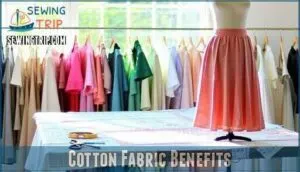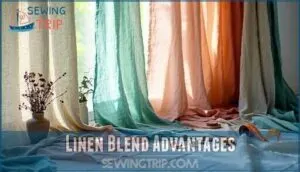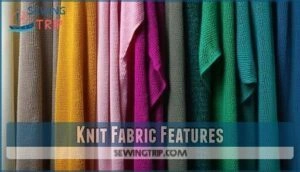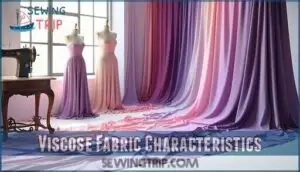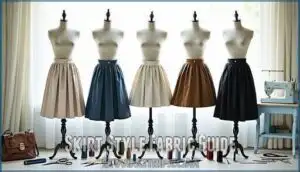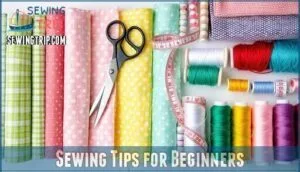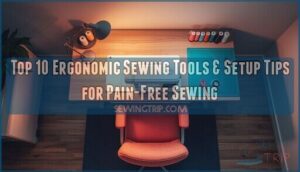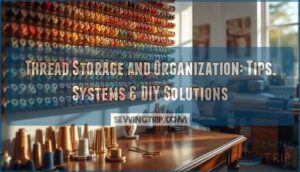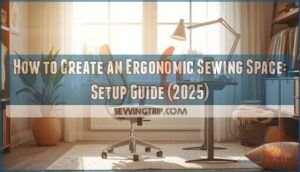This site is supported by our readers. We may earn a commission, at no cost to you, if you purchase through links.
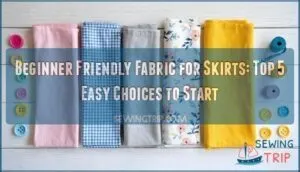
These fabrics forgive mistakes, don’t stretch out of shape, and handle machine washing like champs.
Cotton broadcloth and quilting cotton are your best friends—they’re stable, affordable, and cut cleanly without fraying too much.
Avoid slippery fabrics like satin or stretchy knits until you’ve got your bearings.
Medium-weight fabrics work better than heavy denim or flimsy voile for first projects.
Stick with solid colors or simple patterns to keep things manageable.
The right fabric choice can make or break your sewing confidence, but there’s more to think about than just the material itself.
Table Of Contents
Key Takeaways
- You’ll want to start with cotton or cotton blends since they’re stable, forgiving, and won’t slip around while you’re cutting or sewing, making them perfect for building your confidence as a beginner.
- Choose medium-weight fabrics over heavy denim or flimsy materials, and stick with solid colors or simple patterns to keep your first projects manageable and stress-free.
- Always pre-wash your fabric before cutting to prevent shrinkage and color bleeding that could ruin your finished skirt, and use the right needle size for your fabric weight to avoid damage.
- Match your fabric choice to your skirt style—cotton works great for casual A-line skirts, linen blends are perfect for summer wear, and avoid stretchy knits or slippery fabrics until you’ve mastered the basics.
Choosing Fabric Wisely
When you’re starting your skirt-making journey, you’ll want to keep in mind how easy each fabric is to handle, how much care it needs, and whether it fits your budget and project goals.
The right fabric choice can make or break your first sewing project—choose wisely and sew with confidence.
Smart fabric selection saves you time and frustration, especially when you focus on materials that won’t slip around while you’re cutting or require special washing instructions that complicate your sewing experience.
This approach helps you manage your project more efficiently, ensuring that you’re working with materials that are suitable for your needs, and that’s why smart decisions are crucial from the start.
Ease of Handling
Why struggle with slippery fabrics when you’re learning? Fabric Stability becomes your best friend when choosing beginner skirt fabric.
Easy sew skirt projects demand materials that cooperate, not fight against your scissors and sewing machine. Pre-treating fabrics can greatly improve manageability.
- Cutting Precision: Cotton and chambray won’t shift under your scissors, ensuring clean, accurate cuts every time
- Seam Management: Stable weaves prevent fraying and puckering, making simple skirt material forgiving for new sewers
- Stitch Control: Beginnerfriendly fabrics maintain consistent tension, delivering professional-looking results with basic machine settings
Care Requirements
Nobody wants to babysit their clothes after creating something beautiful.
When selecting washable skirt fabric, prioritize materials with simple care instructions like cotton and linen blends.
These easy care skirt options handle regular washing cycles without drama.
Look for ironfriendly fabric that won’t wrinkle excessively or require special drying methods.
Your fabric care routine should feel manageable, not overwhelming.
Cost and Availability
Budget constraints shouldn’t derail your sewing dreams. Smart shopping makes affordable skirt fabric accessible to every beginner.
Local stores often beat online retailers on convenience, while fabric sales can slash costs dramatically.
Here are five money-saving strategies:
- Discount Options – Check clearance sections first
- Fabric Sales – Time purchases around seasonal promotions
- Online Retailers – Compare prices across multiple sites
- Local Stores – Build relationships for insider deals
- Budget Fabrics – Cotton and basic blends offer excellent value
Project Type
When choosing fabric for your skirt project, consider what you’re actually making.
Different skirt styles demand specific fabric properties that’ll make or break your sewing success.
| Skirt Complexity | Best Fabric | Skill Level |
|---|---|---|
| Simple A-line | Cotton poplin | Beginner |
| Gathered waist | Lightweight cotton | Beginner |
| Pleated design | Medium-weight cotton | Intermediate |
| Wrap style | Viscose rayon | Beginner |
| Pencil fitted | Stretch knit | Advanced |
Match your fabric choices to your project’s occasion wear and durability needs for best results.
Fabric Types Explained
Understanding fabric types becomes your roadmap to successful skirt-making adventures.
Each fabric brings unique characteristics that’ll either support or challenge your sewing journey.
Cotton stands as the classic choice with its stable weave structure and forgiving nature.
Linen offers breathable comfort through its loose weave, perfect for summer projects.
Denim provides durability with its tight twill construction.
Here’s what separates beginner-friendly fabric from tricky options:
- Fabric weights – Medium-weight fabrics hold their shape better than flimsy lightweight materials
- Fiber origins – Natural fibers like cotton and linen behave more predictably than synthetics
- Drape qualities – Structured fabrics create clean lines while flowing materials need advanced handling skills
Fabric blends combine the best features of different materials.
Cotton-polyester blends reduce wrinkles while maintaining cotton’s easy-sew properties.
Understanding these basics helps you match fabric characteristics to your skill level and project goals.
Knowing the fabric’s GSM rating can further help determine its thickness and suitability.
Beginner Friendly Fabrics
When you’re starting your sewing journey, choosing the right fabric can make the difference between a smooth project and a frustrating experience that leaves you wondering why your grandmother made it look so easy.
The best beginner-friendly fabrics share common traits: they’re stable, forgiving, easy to handle, and won’t slip around while you’re cutting or sewing, which makes them forgiving.
Cotton Fabric Benefits
Cotton stands out as the ultimate beginner-friendly fabric for your first skirt project.
This breathable fabric offers cotton breathability that keeps you comfortable while being incredibly easy sewing material.
You’ll love its versatile styles potential, from A-line to gathered designs.
Machine washable convenience means low maintenance, and its durable nature forgives mistakes while you perfect your fabric selection skills.
Linen Blend Advantages
Linen blends offer beginners the perfect balance between elegance and practicality.
These breathable fabrics combine linen’s natural cooling properties with improved durability and cost savings. Linen’s versatility is enhanced through blending, which can create various fabric properties.
Here’s why linen blends excel as beginner-friendly fabric choices:
- Wrinkle Resistance – Cotton-linen combinations reduce creasing substantially
- Drape Improvement – Blending benefits create smoother, more manageable fabric flow
- Texture Variety – Multiple blend ratios offer diverse aesthetic options
- Enhanced Durability – Stronger construction withstands beginner sewing mistakes better
Knit Fabric Features
Flexibility becomes your best friend when working with knit fabrics for skirts.
These beginner-friendly fabric options offer natural stretch, making them forgiving for measurement mistakes.
Knit Fabric Stretch eliminates the need for complex Seam Finishing Options since edges don’t fray.
Perfect for Elastic Waistbands and comfortable Knit Skirt Styles, these breathable, lightweight materials make ideal Beginner Knit Projects.
Knit fabrics are held together by interlooping yarns around each other.
| Feature | Benefit |
|---|---|
| Natural stretch | Forgiving fit and comfort |
| No fraying edges | Simplified seam finishing |
| Lightweight feel | Easy handling and draping |
| Breathable texture | All-day wearing comfort |
| Elastic compatibility | Simple waistband construction |
Viscose Fabric Characteristics
Viscose offers the perfect balance of luxury and affordability for your first skirt project.
This rayon skirt fabric mimics silk’s elegance without breaking the bank, making it ideal for flowy designs.
Here’s why you’ll love working with this breathable skirt fabric:
- Viscose drape creates stunning movement – your skirts will flow like a dream
- Soft texture feels amazing against your skin all day long
- Viscose cost won’t empty your wallet like premium fabrics
- Lightweight skirt fabric keeps you comfortable in any weather
- Sewing viscose teaches valuable draping skills for future projects.
Remember to pre-wash this flowy skirt fabric before cutting – viscose shrinkage can surprise beginners and ruin perfectly planned measurements.
Skirt Style Fabric Guide
You’ll discover that matching the right fabric to your skirt style makes sewing much easier and gives you better results.
Different skirt designs work best with specific fabric types, so understanding these combinations helps you choose materials that won’t fight against your pattern’s intended shape and drape.
Cotton for Casual Skirts
When you’re ready to tackle your first casual skirt project, cotton delivers unmatched Cotton Comfort for beginner-friendly fabric choices.
This breathable material offers various Weave Types from crisp poplin to soft lawn, giving you endless Print Selection options.
Cotton’s Durability Factors mean your skirt-making experiments won’t fall apart, while flexible Styling Options let you create everything from gathered peasant skirts to structured A-lines effortlessly.
For best results, remember to pre-wash the fabric to prevent shrinkage.
Linen for Summer Skirts
When summer heat makes you want to ditch heavy fabrics, linen becomes your best friend for breathable comfort.
This beginnerfriendly fabric offers unmatched linen breathability that keeps you cool during scorching days.
Here’s why linen skirt fabric works perfectly for summer wear:
- Natural airflow – loose weave allows cooling circulation
- Moisture-wicking properties – absorbs sweat effectively
- Linen blends reduce wrinkles – easier maintenance than pure linen
Summer styles become effortless with proper care tips.
Wool for Cold Weather
Wool warmth becomes your best friend when colder seasons arrive.
This beginner-friendly fabric offers exceptional insulation while maintaining breathability.
Knit wool provides comfortable stretch for skirtmaking, while custom varieties create structured silhouettes.
Merino and wool blends eliminate traditional itchiness concerns.
Wool types range from lightweight to heavy, adapting to your climate needs.
Proper wool care guarantees lasting durability and shape retention.
Denim for Classic Skirts
Durable denim makes skirtmaking foolproof for beginners.
This sturdy fabric holds its shape beautifully, whether you’re creating mini or A-line styles.
Denim weight varies from lightweight chambray to heavy-duty options.
Choose medium-weight denim for easier handling.
The durability means your handmade skirt will last years.
Pre-wash to prevent shrinkage, then enjoy stress-free sewing with this forgiving, classic fabric choice.
Sewing Tips for Beginners
You’ll need to prepare your fabric properly before you start cutting and sewing your first skirt.
These simple preparation steps, from pre-washing to choosing the right needle, will help you avoid common mistakes and create a skirt that fits well and lasts longer.
Pre-Washing Fabric
Something everyone learns the hard way: prewash your fabric before cutting. This simple step prevents heartbreak when your finished skirt shrinks or colors bleed during the first wash.
Never skip the pre-wash step – it’s the difference between a perfect fit and a ruined project.
To enhance the cleaning process, consider using a specialized laundry solution.
- Shrinkage allowance – Cotton and linen can shrink up to 5%
- Color bleeding – Dark fabrics may release dye onto lighter materials
- Texture change – Some fabrics become softer or stiffer after washing
- Wrinkle prevention – Pre-washing reveals fabric’s natural drape
- Fabric stabilization – Eliminates unexpected stretching during construction
Ironing and Cutting
Iron your cotton skirt fabric before cutting to eliminate wrinkles and guarantee accurate measurements.
Set appropriate ironing temperatures for different materials—cotton handles high heat while linen needs medium settings.
Achieving the best results may require specialized ironing tools.
Proper fabric stabilization prevents shifting during cutting.
Use sharp cutting tools and align your pattern with the fabric’s grain for professional results.
These sewing techniques and cutting techniques create clean, precise edges every time.
Choosing Right Needles
How do you pick the perfect sewing machine needles for your fabric choice? Getting needle compatibility right prevents fabric damage and guarantees smooth stitching from the start of your sewing journey.
- Needle size matters: Use sizes 8-10 for lightweight fabrics, 12-14 for medium-weight materials, and 16-18 for heavy fabrics
- Needle types vary: Universal needles work for most projects, while ballpoint needles prevent runs in knits
- Changing needles regularly: Replace after each project to maintain clean, professional-looking stitches and avoid frustrating snags. Refer to a needle size guide for help selecting the correct needle.
Practicing on Scrap Fabric
Before tackling your practice garment, grab some classic cotton muslin for tension adjustment and stitch length testing.
Your sewing machine needs calibration for different fabric combinations, and curve practice on scraps prevents costly mistakes.
Create fabric prototypes to master seam finishes before cutting your good material.
To fine-tune your machine, remember to perform tension adjustment tests on scrap fabric, which is a crucial step for saving time, and this sewing practice saves money, and frustration later.
Frequently Asked Questions (FAQs)
What is the easiest skirt to make for beginners?
Picture yourself sitting at your sewing machine, ready to create something beautiful.
You’ll find that a simple A-line skirt using cotton fabric becomes your perfect starting point—it’s forgiving, structured, and builds essential skills, making it an ideal project for beginners.
What is the best fabric for beginner apparel?
Cotton tops the list for beginner apparel makers.
You’ll find it stable, forgiving, and machine-washable.
It doesn’t slip while cutting or sewing, making your first projects smoother and building confidence naturally.
What type of fabric should I use for a skirt?
Sure, you could wrestle with silk like it’s your nemesis, but why torture yourself?
Start with cotton—it’s forgiving, stable, and won’t slip around like a greased pig while you’re learning to sew.
What is the easiest fabric for beginners?
When you’re starting out, quilting cotton is your best friend.
It’s stable, doesn’t slip around, and forgives mistakes beautifully.
You’ll find it affordable, easy to handle, and perfect for building confidence.
Can I mix different fabrics in one skirt?
Yes, you can mix fabrics, but keep weights similar and consider drape differences.
Try combining cotton with linen blends or adding contrasting waistbands.
Test combinations first to verify they sew together smoothly.
What fabric weight works best for pleated skirts?
Medium-weight fabrics work best for pleated skirts since they’ll hold crisp folds without being too stiff.
You’ll want something with body like cotton poplin, wool crepe, or structured linen that maintains shape beautifully.
How do I prevent fabric from fraying edges?
Fraying fabric edges can turn your beautiful skirt into a hot mess faster than you can say "unraveling disaster."
Use pinking shears, serger stitching, or zigzag machine stitches to seal edges and prevent threads from escaping their fabric prison.
Which fabrics require special sewing machine settings?
Knit fabrics need ballpoint needles and zigzag stitches to prevent skipped stitches.
Denim requires heavy-duty needles and strong thread.
Silk needs delicate settings with low tension.
Adjust your machine’s pressure foot for different fabric weights.
Whats the difference between woven and knit fabrics?
Like choosing between a flexible yoga mat and a sturdy board, you’re picking fabric structure.
Woven fabrics have interlocked threads creating stability, while knits loop together for stretch and comfort—each serving different sewing needs perfectly.
Conclusion
Success in sewing resembles planting a garden—choosing the right foundation guarantees everything else flourishes.
Your journey with beginner friendly fabric for skirts starts with these smart material choices. Cotton and cotton blends won’t betray you when you’re learning new techniques.
Remember, every expert seamstress once fumbled with their first seam. Start with forgiving fabrics, practice consistently, and you’ll develop the confidence to tackle any project.
Your sewing skills will grow stronger with each stitch you make, and this progress is a result of consistent practice and using the right materials, ultimately leading to expert seamstress levels.
- https://www.instagram.com/explore/tags/bfsandwashedcotton
- https://www.seamwork.com/catalog/hansie?rfsn=6464216.d24786
- https://sewport.com/fabrics-directory/jersey-fabric
- https://www.slideshare.net/slideshow/introduction-to-knit-fabrics/227619370
- https://www.sciencedirect.com/topics/engineering/fabric-layer

